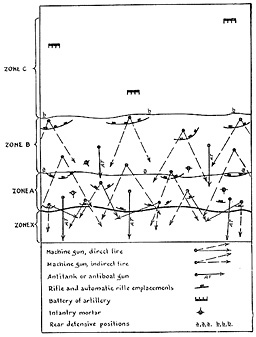
Chapter 6
Naval Gunfire
| Paragraphs | ||
|---|---|---|
| Section I. | Targets and fire missions | 151-157 |
| II. | Characteristics | 158-166 |
| III. | Requirements in guns and ammunition | 167-171 |
| IV. | Coordination of fire | 172-175 |
Section I
Targets and Fire Missions
-
Characteristics of defense Positions.--
- To plan the artillery fire support for a landing operation, it is necessary to understand the characteristics of a defensive position. these characteristics are similar for either a coast line or an inland position.
- Defensive fires may be opened initially at maximum ranges of the weapons, and thereafter maintained on the approaching boats or troops. The fires which may be expected immediately in front of a defensive position are shown in zone X, figure 16. This zone may be along and immediately to seaward of the beach or in front of an inland position. A heavy concentration of fire of all types of weapons may be expected on the ground or water over which the attacking troops must advance.
- The bulk of the fires in zone X are delivered by rifles, automatic rifles, machine guns, and antiboat or antitank guns, located in or near the enemy front lines, and capable of delivering direct fire upon the approaching boats or troops. Some field artillery weapons may be located in zone A for the purpose of executing direct fire on small boats approaching the shore and delivering enfilade fire on critical sections of the beach. Some large caliber artillery weapons may also be well forward to execute fire on transports while they are unloading men into small boats. Zone A, in which these direct-fire weapons are located, may extend a distance of several hundred yards in rear of the enemy front line, depending upon the terrain, but those located close to the front line are the more dangerous to the attacker.
